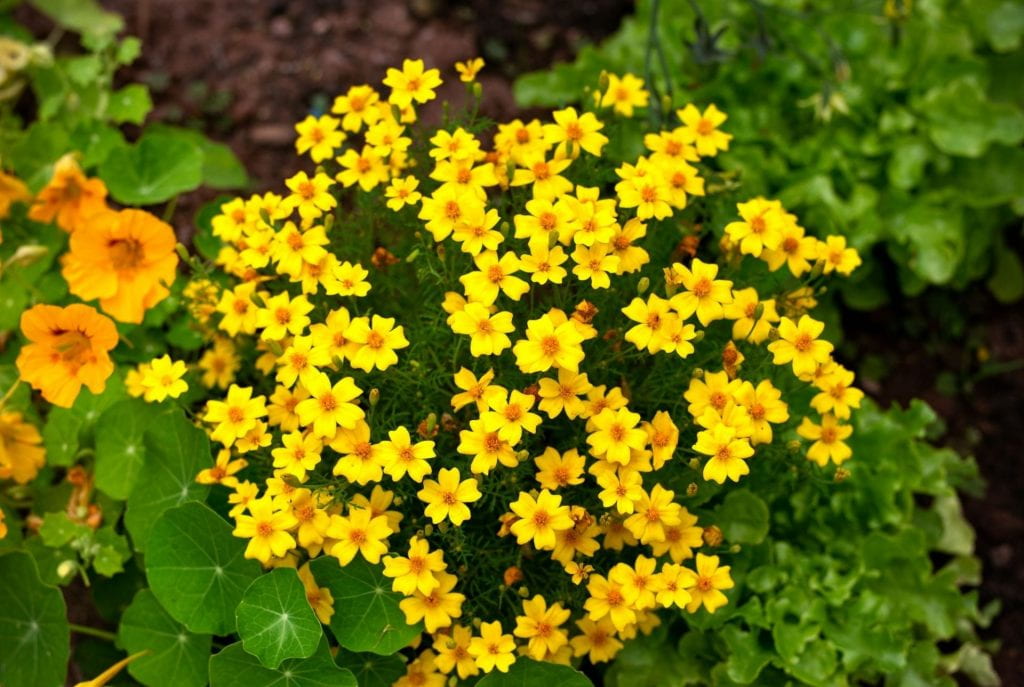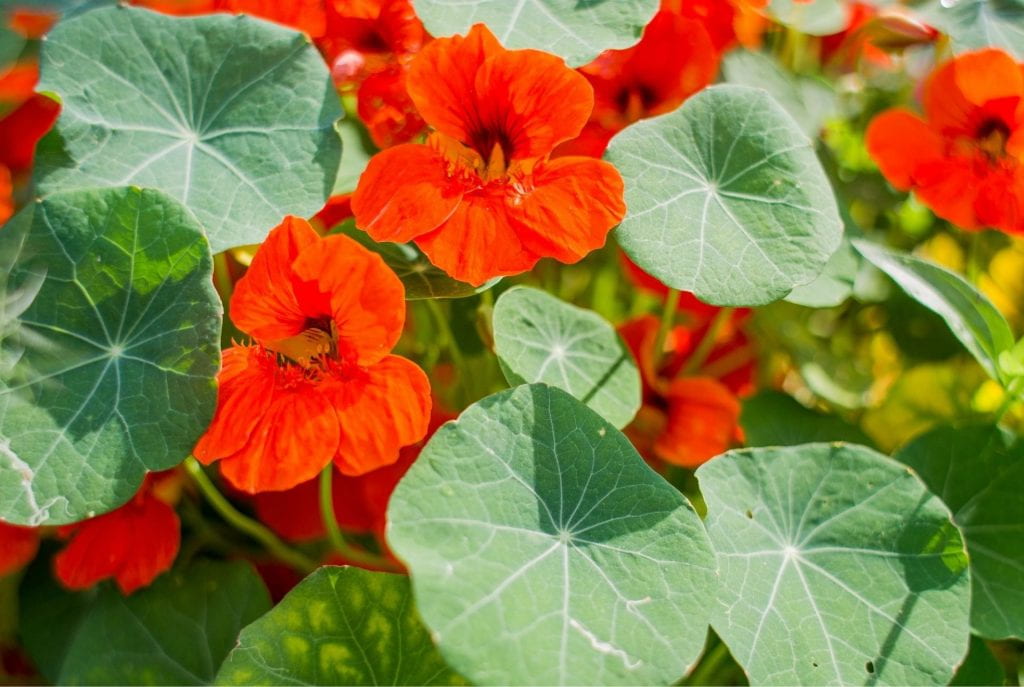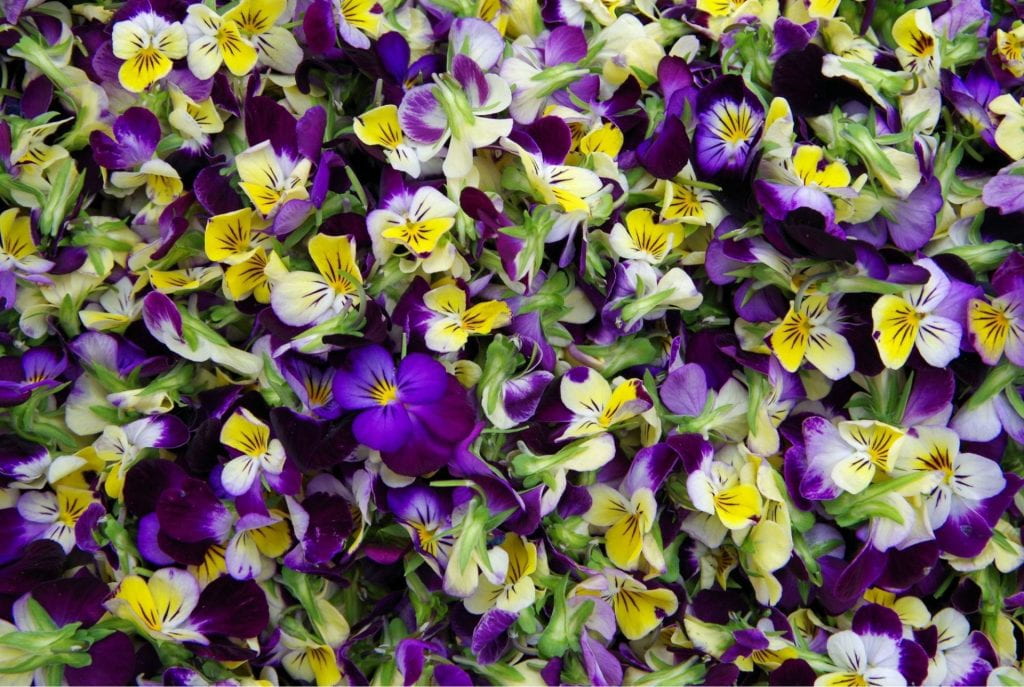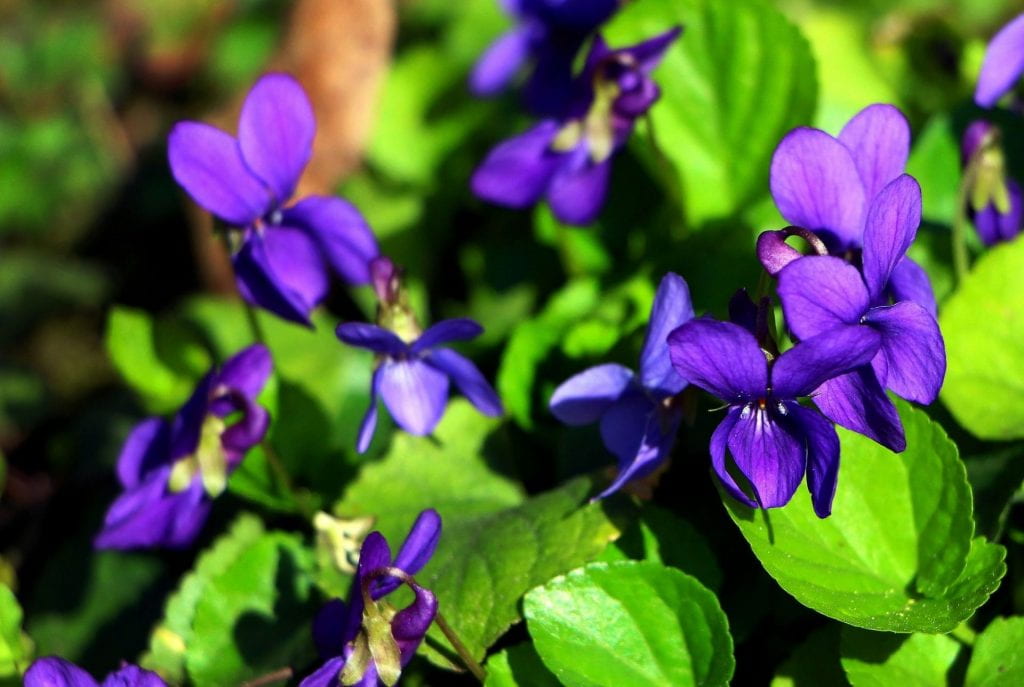I’ve heard it said that we eat with all our senses and I whole-heartedly believe this is true. In no case is this truth more evident than in the consumption of flowers. From sturdy blossoms to the most delicate of petals, these colorful beauties are delicious. There are, however, rules that must be followed (see below).
Start simple, with plants you may already be familiar with. My family has always grown marigolds, nasturtiums, pansies, and violets, so that’s what I have my personal experience with. As I researched this article, I discovered many more flowers that I hadn’t known about. Hurrah! New flavors are on my horizon.
While you learn your way through eating blossoms, keep some notes. Here’s a starter for you, based on my favorites.

Marigolds (Tagetes): Some plants called “Marigolds” are actually of the Calendula, Caltha, or Glebionis genera. I’m referring only to today’s most common marigold, the Tagetes. Some marigolds taste like citrus, some more spicy, some simply taste “plant-y.” You’ll want to taste-test, but I’ve listed a few that taste good to me.
- Favorite varieties: Bonanza Mix, Flagstaff, Inca II, Lemon Gem, Tangerine Gem.
- Culinary notes: may stain food (nickname: ‘poor man’s saffron’), citrusy to spicy flavor depending on type
- Growing notes: space 12-18” apart to allow light to get to all sides of the plant, deadhead blossoms to keep them blooming, organic fertilizer at base of plant — never on blossoms.

Nasturtiums (Tropaeolum majus): These are sweet, spicy, and peppery. I like them best in salad.
- Favorite varieties: Nasturtium Tropaeolum majus, I like the salmon-colored blossoms the best.
- Culinary notes: leaves are peppery and lovely in salads. Blossoms are sweet and spicy, a taste in the same genre as watercress. I usually drop small blossoms into a salad whole, but I’ve recently read that they are delicious stuffed with a cold filling. I think I’ll try Boursin and cream cheese whipped in 1:1 proportion. Seed pods are also edible, with a mustard-y taste. More than one source tells me that they may be pickled and used like capers, though I’ve never eaten the seeds.
- Growing notes: Nasturtiums grow well in poor soil, though it must be well-draining. They prefer full sun for the best blooms. Tropaeolum majus is a trailing or climbing type, great for window boxes or for following peas up the trellis. Take care not to overwater. Deadhead blooms to prolong blooming. Know that heat-stressed flowers may stop blooming, and their flavor may become more intense which is not always a bad thing, so if they slow down, try putting something near/over to provide a little shade.

Pansy (Viola Tricolor L or Viola wittrockiana Gams): Pansies have a sweet, lettuce-y taste, and preparation is easy – no need to separate the flower into parts; the whole thing is edible.
- Favorite varieties: I have no clue! I just keep eating the Johnny Jump-Ups that have reseeded themselves since they were given to me 18 years ago.
- Culinary notes: Pansies are the easiest to eat because you can eat the whole head. It’s all edible: stamen, pistil and sepals (the leaves under the blossom that come off when you pop the whole head off the stem). They taste a lot like a slightly spicy lettuce when they are raw. When I was much younger and into experimenting, I candied the flowers along with some violet blooms and pressed them into the frosting of a birthday cake. It was a hit! I don’t bother with the candying anymore, I just stick the clean, dry flower head onto a Ritz cracker that’s been spread with cream cheese. Heaven!
- Growing notes: We usually see pansies planted in sunlight, front and center, because they are so cheery and can tolerate the early spring coolness. In fact, they’ll flower best if they get morning sun and shade during the hottest part of the day. They prefer consistent moisture and well drained soil will keep them from getting root rot. They’re a little picky about the heat—too much heat and they’ll stop blooming. Feed them every couple of weeks with a balanced fertilizer applied to the roots. 10-10-10 is good, or if you feel like the green of the foliage is looking sickly, something with slightly higher nitrogen (the first number). When you deadhead, be sure to follow the stem all the way down to the first set of leaves and snip just above them.

Violets (Viola sororia): Violets are nutritious, having relatively high amounts of vitamins C and A in both the leaves and blossoms. Know that violets contain saponin, so eating a lot can bring on digestive issues. They are sometimes used to make syrups, teas, and baked goods, but I like to add them to salads. Alas, they come early in the spring, so I have to remember to get my butter lettuce in the ground early enough to coincide with the violet blossoms!
- Favorite varieties: I forage the violets from beneath the trees in our stand of evergreens, apple trees, and birch trees, and from the edges of my yard. Warning: violets (from the viola family) are not the same as African Violets.
- Culinary notes: Viola adorate is a blueish purple, and seems to agree with most people’s digestion, but I’ve seen anecdotes that the white and the yellow flowers don’t sit well with everyone. I’ve only eaten the purple ones. Lesson learned while researching this article (I’ve not tried it yet, but I will) is that the greens are the star of the plant! WHAT!? Apparently you can cook the greens the same as any other greens, but note that the tender spring leaves are the ones you want in your salad. The greens toughen up quickly and may require blanching, or even take them for a spin in the food processor and add them to soups/stews. They cook similarly to spinach—smooth and silky, and they shrink down a lot. Lastly, note that the raw stems of the violet plant can cause a reaction in the throat (hot and uncomfortable) if eaten in quantity, so follow the rule about starting with small quantities of any food.
- Growing notes: This flowering perennial grows in damp, well-drained soil with plenty of organic matter, in both shade and sun, and come back year after year. They’ll spread into a carpet if you let them as they spread by rhizomes. Some of the websites say that they bloom in the spring or the fall, or both. Mine start blooming in the spring and stop blooming when they get frosted. I wonder if it’s because I keep popping their little blossoms off – since they never go to seed, they never stop blooming. Transplant in early spring, or dig an intact colony in one shovelful in the fall.
The Rules
- Before consuming just any flower, check with a medical professional or a reliable plant resource.
- Never ever “experiment” to discover if a plant is edible. Remember that medications originated from plants, and you have no idea what an unidentified plant or blossom might do to your body.
- Do not eat flowers or plants from anywhere that you do not know their history. Pesticides and other mystery chemicals may be on the plant and should never be ingested.
- Never take plants from the roadside. (See number 3.)
- Know the flower’s exact identity; eat only the parts you know to be edible.
- Use flowers sparingly until you know how your body reacts to the “new” food, possibly only trying one new variety of blossom at a time.
- Shake each blossom gently while outside, to discharge any hitchhiking insects. Then do a soft, floating rinse in a bowl of very cold water, spin dry or blot with a soft cloth. Store on damp cloth in a sealed container in the fridge for less than 24 hours.
Sources beyond my own experience.
www.almanac.com The Old Farmer’s Almanac has proved to be a reliable resource for information on weather, astronomy, gardening, and health. Their articles are interspersed with citations of scientific studies, rumor-debunking, and occasional old-timey wisdom.
www.gardengatemagazine.com Garden Gate Magazine articles are diverse, from growing, using, and designing with plants to projects and garden plans. And their pictures are just lovely.
www.foragerchef.com This site has good photos for identification purposes, lovely artsy photos, some general information and recipes!
www.wildfoodshomegarden.com The subtitle of this website says it all: How to grow & use wild plants, shrubs, trees and mushrooms. A practical guide using organic gardening methods.
